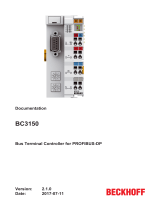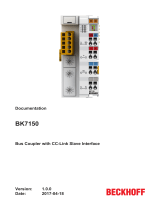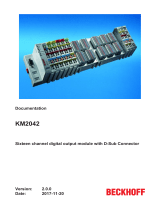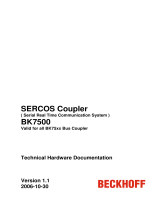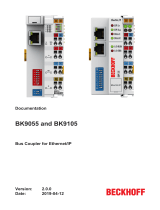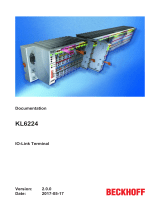Page is loading ...

Documentation
BC5250
Bus Terminal Controller for DeviceNet
2.0.0
2017-07-18
Version:
Date:


Table of contents
BC5250 3Version: 2.0.0
Table of contents
1 Foreword ....................................................................................................................................................5
1.1 Notes on the documentation........................................................................................................... 5
1.2 Safety instructions .......................................................................................................................... 6
1.3 Documentation issue status............................................................................................................ 7
2 Product overview.......................................................................................................................................8
2.1 BCxx50 Overview ........................................................................................................................... 8
2.2 The principle of the Bus Terminal ................................................................................................... 9
2.3 The Beckhoff Bus Terminal system ................................................................................................ 9
2.4 Technical data .............................................................................................................................. 12
2.4.1 Technical Data - BCxx50 ................................................................................................12
2.4.2 Technical data - DeviceNet..............................................................................................14
2.4.3 Technical Data - PLC.......................................................................................................15
3 Mounting and wiring ...............................................................................................................................16
3.1 Mounting ....................................................................................................................................... 16
3.1.1 Dimensions ......................................................................................................................16
3.1.2 Installation........................................................................................................................17
3.2 Wiring............................................................................................................................................ 18
3.2.1 Potential groups, insulation testing and PE .....................................................................18
3.2.2 Power supply....................................................................................................................20
3.2.3 Programming cable..........................................................................................................21
3.2.4 DeviceNet cabling ............................................................................................................22
4 Parameterization and Commissioning ..................................................................................................27
4.1 Start-up behavior of the Bus Terminal Controller ......................................................................... 27
4.2 Configuration ................................................................................................................................ 27
4.2.1 Overview ..........................................................................................................................27
4.2.2 Creating a TwinCAT configuration ...................................................................................29
4.2.3 Downloading a TwinCAT configuration............................................................................30
4.2.4 Uploading a TwinCAT configuration ................................................................................32
4.2.5 Resources in the Bus Terminal Controller .......................................................................33
4.2.6 ADS connection via serial interface .................................................................................36
4.2.7 DeviceNet slave interface ................................................................................................37
4.2.8 K-bus................................................................................................................................45
4.2.9 PLC ..................................................................................................................................47
4.2.10 Configuration software KS2000 .......................................................................................50
5 Programming ...........................................................................................................................................51
5.1 BCxx50 PLC features ................................................................................................................... 51
5.2 TwinCAT PLC ............................................................................................................................... 51
5.3 TwinCAT PLC - Error codes ......................................................................................................... 52
5.4 Remanent data ............................................................................................................................. 54
5.5 Allocated flags .............................................................................................................................. 55
5.6 Local process image in delivery state........................................................................................... 56
5.7 Mapping the Bus Terminals .......................................................................................................... 57
5.8 Creating a boot project ................................................................................................................. 57
5.9 Local process image in the TwinCAT configuration...................................................................... 58
5.10 Communication between TwinCAT and BX/BCxx50 .................................................................... 59
5.11 Up- and downloading of programs................................................................................................ 60
5.12 Libraries ........................................................................................................................................ 64

Table of contents
BC52504 Version: 2.0.0
5.12.1 Libraries overview ............................................................................................................64
5.12.2 Data structure strBX5200_Set .........................................................................................65
5.12.3 TcBaseBX ........................................................................................................................67
5.13 Program transfer via the serial interface....................................................................................... 71
6 DeviceNet communication......................................................................................................................73
6.1 DeviceNet Introduction ................................................................................................................. 73
6.2 Network Management................................................................................................................... 74
6.3 Object directory............................................................................................................................. 74
6.4 ADS-Communication .................................................................................................................... 75
6.4.1 ADS services....................................................................................................................75
7 Error handling and diagnosis.................................................................................................................77
7.1 Diagnostics ................................................................................................................................... 77
7.2 Diagnostic LEDs ........................................................................................................................... 79
8 Appendix ..................................................................................................................................................82
8.1 Firmware Update .......................................................................................................................... 82
8.2 General operating conditions........................................................................................................ 84
8.3 Approvals...................................................................................................................................... 85
8.4 Test standards for device testing.................................................................................................. 86
8.5 Bibliography .................................................................................................................................. 86
8.6 List of Abbreviations ..................................................................................................................... 86
8.7 Support and Service ..................................................................................................................... 88

Foreword
BC5250 5Version: 2.0.0
1 Foreword
1.1 Notes on the documentation
Intended audience
This description is only intended for the use of trained specialists in control and automation engineering who
are familiar with the applicable national standards.
It is essential that the documentation and the following notes and explanations are followed when installing
and commissioning these components.
It is the duty of the technical personnel to use the documentation published at the respective time of each
installation and commissioning.
The responsible staff must ensure that the application or use of the products described satisfy all the
requirements for safety, including all the relevant laws, regulations, guidelines and standards.
Disclaimer
The documentation has been prepared with care. The products described are, however, constantly under
development.
We reserve the right to revise and change the documentation at any time and without prior announcement.
No claims for the modification of products that have already been supplied may be made on the basis of the
data, diagrams and descriptions in this documentation.
Trademarks
Beckhoff
®
, TwinCAT
®
, EtherCAT
®
, Safety over EtherCAT
®
, TwinSAFE
®
, XFC
®
and XTS
®
are registered
trademarks of and licensed by Beckhoff Automation GmbH.
Other designations used in this publication may be trademarks whose use by third parties for their own
purposes could violate the rights of the owners.
Patent Pending
The EtherCAT Technology is covered, including but not limited to the following patent applications and
patents: EP1590927, EP1789857, DE102004044764, DE102007017835 with corresponding applications or
registrations in various other countries.
The TwinCAT Technology is covered, including but not limited to the following patent applications and
patents: EP0851348, US6167425 with corresponding applications or registrations in various other countries.
EtherCAT
®
is registered trademark and patented technology, licensed by Beckhoff Automation GmbH,
Germany
Copyright
© Beckhoff Automation GmbH & Co. KG, Germany.
The reproduction, distribution and utilization of this document as well as the communication of its contents to
others without express authorization are prohibited.
Offenders will be held liable for the payment of damages. All rights reserved in the event of the grant of a
patent, utility model or design.

Foreword
BC52506 Version: 2.0.0
1.2 Safety instructions
Safety regulations
Please note the following safety instructions and explanations!
Product-specific safety instructions can be found on following pages or in the areas mounting, wiring,
commissioning etc.
Exclusion of liability
All the components are supplied in particular hardware and software configurations appropriate for the
application. Modifications to hardware or software configurations other than those described in the
documentation are not permitted, and nullify the liability of Beckhoff Automation GmbH & Co. KG.
Personnel qualification
This description is only intended for trained specialists in control, automation and drive engineering who are
familiar with the applicable national standards.
Description of symbols
In this documentation the following symbols are used with an accompanying safety instruction or note. The
safety instructions must be read carefully and followed without fail!
DANGER
Serious risk of injury!
Failure to follow the safety instructions associated with this symbol directly endangers the
life and health of persons.
WARNING
Risk of injury!
Failure to follow the safety instructions associated with this symbol endangers the life and
health of persons.
CAUTION
Personal injuries!
Failure to follow the safety instructions associated with this symbol can lead to injuries to
persons.
Attention
Damage to the environment or devices
Failure to follow the instructions associated with this symbol can lead to damage to the en-
vironment or equipment.
Note
Tip or pointer
This symbol indicates information that contributes to better understanding.

Foreword
BC5250 7Version: 2.0.0
1.3 Documentation issue status
Version Comment
2.0.0 • Migration
1.1.0 • Notes to meet the UL requirements added.
1.0.0 • First public issue
BC5250 firmware
For updating your firmware you need a serial cable, the KS2000 configuration software, or the firmware
update program.
Firmware Comment
0xB1 Firmware version 0xB1
The firmware and hardware versions (delivery state) can be found on the sticker on the underside of the Bus
Terminal Controller.

Product overview
BC52508 Version: 2.0.0
2 Product overview
2.1 BCxx50 Overview
Bus Terminal Controllers are Bus Couplers with integrated PLC functionality. The BCxx50 Bus Terminal
Controllers have a fieldbus interface, are intelligent slaves and can be used as decentralized intelligence
within the system. They are located in a cost-optimized and compact housing. In contrast to the BCxx00
range, the BCxx50 range supports up to 255Bus Terminals via the K-Bus extension.
The Bus Terminal Controller is programmed using the TwinCAT programming system according to IEC
61131-3. The BCxx50 configuration/programming interface is used for loading the PLC program. If the
TwinCAT software PLC is in use, the PLC program can also be loaded via the fieldbus.
The inputs and outputs of the connected Bus Terminals are assigned in the default setting of the mini-PLC.
Each individual Bus Terminal can be configured in such a way that it exchanges data directly through the
fieldbus with the higher-level automation device. Similarly, pre-processed data can be exchanged between
the Bus Terminal Controller and the higher-level controller via the fieldbus.
Fieldbus interface
The variants of the BCxx50 series Bus Terminal Controllers differ in terms of their fieldbus interfaces.
Various versions cover the most important fieldbus systems:
• BC3150: PROFIBUS DP
• BC5150: CANopen
• BC5250: DeviceNet
• BC8050: RS485, various protocols
• BC8150: RS232, various protocols
Programming
The BCxx50 devices are programmed according to the powerful IEC 61131-3 standard. Like for all other
BECKHOFF controllers, the TwinCAT automation software is the basis for parameterization and
programming. Users therefore have the familiar TwinCAT tools available, e.g.PLC programming interface,
System Manager and TwinCAT Scope. Data is exchanged optionally via the serial interface (COM1) or via
the fieldbus through Beckhoff PC FCxxxx fieldbus cards.
Configuration
The configuration is also carried out using TwinCAT. The fieldbus interface can be configured and
parameterized via the System Manager. The System Manager can read all connected devices and Bus
Terminals. After the parameterization, the configuration is saved on the BCxx50 via the serial interface. The
configuration thus created can be accessed again later.

Product overview
BC5250 9Version: 2.0.0
2.2 The principle of the Bus Terminal
Fig.1: The principle of the Bus Terminal
2.3 The Beckhoff Bus Terminal system
Up to 256 Bus Terminals, with 1 to 16I/O channels per signal form
The Bus Terminal system is the universal interface between a fieldbus system and the sensor / actuator
level. A unit consists of a Bus Coupler as the head station, and up to 64 electronic series terminals, the last
one being an end terminal. Up to 255 Bus Terminals can be connected via the K-bus extension. For each
technical signal form, terminals are available with one, two, four or eight I/O channels, which can be mixed
as required. All the terminal types have the same mechanical construction, so that difficulties of planning and
design are minimized. The height and depth match the dimensions of compact terminal boxes.
Decentralised wiring of each I/O level
Fieldbus technology allows more compact forms of controller to be used. The I/O level does not have to be
brought to the controller. The sensors and actuators can be wired decentrally, using minimum cable lengths.
The controller can be installed at any location within the plant.
Industrial PCs as controllers
The use of an Industrial PC as the controller means that the operating and observing element can be
implemented in the controller's hardware. The controller can therefore be located at an operating panel, in a
control room, or at some similar place. The Bus Terminals form the decentralised input/output level of the

Product overview
BC525010 Version: 2.0.0
controller in the control cabinet and the subsidiary terminal boxes. The power sector of the plant is also
controlled over the bus system in addition to the sensor/actuator level. The Bus Terminal replaces the
conventional series terminal as the wiring level in the control cabinet. The control cabinet can have smaller
dimensions.
Bus Couplers for all usual bus systems
The Beckhoff Bus Terminal system unites the advantages of a bus system with the possibilities of the
compact series terminal. Bus Terminals can be driven within all the usual bus systems, thus reducing the
controller parts count. The Bus Terminals then behave like conventional connections for that bus system. All
the performance features of the particular bus system are supported.
Mounting on standardized mounting rails
The installation is standardized thanks to the simple and space-saving mounting on a standardized mounting
rail (EN60715, 35mm) and the direct wiring of actuators and sensors, without cross connections between
the terminals. The consistent labelling scheme also contributes.
The small physical size and the great flexibility of the Bus Terminal system allow it to be used wherever a
series terminal is also used. Every type of connection, such as analog, digital, serial or the direct connection
of sensors can be implemented.
Modularity
The modular assembly of the terminal strip with Bus Terminals of various functions limits the number of
unused channels to a maximum of one per function. The presence of two channels in one terminal is the
optimum compromise of unused channels and the cost of each channel. The possibility of electrical isolation
through potential feed terminals also helps to keep the number of unused channels low.
Display of the channel state
The integrated LEDs show the state of the channel at a location close to the sensors and actuators.
K-bus
The K-bus is the data path within a terminal strip. The K-bus is led through from the Bus Coupler through all
the terminals via six contacts on the terminals' side walls. The end terminal terminates the K-bus. The user
does not have to learn anything about the function of the K-bus or about the internal workings of the
terminals and the Bus Coupler. Many software tools that can be supplied make project planning,
configuration and operation easy.
Potential feed terminals for isolated groups
The operating voltage is passed on to following terminals via three power contacts. You can divide the
terminal strip into arbitrary isolated groups by means of potential feed terminals. The potential feed terminals
play no part in the control of the terminals, and can be inserted at any locations within the terminal strip.
Up to 64Bus Terminals can be used in a terminal block, with optional K-bus extension for up to 256Bus
Terminals. This count does include potential feed terminals, but not the end terminal.
Bus Couplers for various fieldbus systems
Various Bus Couplers can be used to couple the electronic terminal strip quickly and easily to different
fieldbus systems. It is also possible to convert to another fieldbus system at a later time. The Bus Coupler
performs all the monitoring and control tasks that are necessary for operation of the connected Bus
Terminals. The operation and configuration of the Bus Terminals is carried out exclusively by the Bus
Coupler. Nevertheless, the parameters that have been set are stored in each Bus Terminal, and are retained
in the event of voltage drop-out. Fieldbus, K-bus and I/O level are electrically isolated.
If the exchange of data over the fieldbus is prone to errors or fails for a period of time, register contents (such
as counter states) are retained, digital outputs are cleared, and analog outputs take a value that can be
configured for each output when commissioning. The default setting for analog outputs is 0 V or 0 mA. Digital

Product overview
BC5250 11Version: 2.0.0
outputs return in the inactive state. The timeout periods for the Bus Couplers correspond to the usual
settings for the fieldbus system. When converting to a different bus system it is necessary to bear in mind the
need to change the timeout periods if the bus cycle time is longer.
The interfaces
A Bus Coupler has six different methods of connection. These interfaces are designed as plug connectors
and as spring-loaded terminals.

Product overview
BC525012 Version: 2.0.0
2.4 Technical data
2.4.1 Technical Data - BCxx50
Technical data BCxx5x
Processor 16bit micro-controller
Diagnostics LEDs 2 x power supply, 2 x K-Bus
Configuration and programming software TwinCAT PLC
Fieldbus interface BC3150
Fieldbus PROFIBUS DP
Interfaces
Serial interface COM1 (RS232 for configuration and programming, automatic
baud rate detection 9600/19200/38400 baud)
Terminal Bus (K-Bus) 64 (255 with K-bus extension)

Product overview
BC5250 13Version: 2.0.0
Technical data BC3150
Digital peripheral signals 2040 inputs/outputs
Analog peripheral signals 128 inputs/outputs
Configuration possibility via TwinCAT or the controller
Maximum fieldbus byte number 512 bytes input and 512 bytes output
Maximum number of bytes - PLC 2048bytes of input data, 2048bytes of output data
Bus connection D-sub, 9-pin
Power supply (Us) 24V
DC
(-15% /+20%) Use a 4A fuse or an NEC Class2 power
supply to meet the UL requirements!
Input current (Us) 60mA + (total K-bus current)/4
Starting current approx. 2.5 x continuous current
K-bus current (5V) maximum 1000mA
Power contact voltage (Up) maximum 24V
DC
Power contact current load (Up) maximum 10A
Recomm. back-up fuse (Up) ≤10A
Dielectric strength 500V (power contact/supply voltage/fieldbus)
Weight approx. 100g
Dimensions (W x H x D) approx. 44mm x 100mm x 68mm
Permissible ambient temperature range
during operation
-25°C ... +60°C
Permissible ambient temperature range
during storage
-40 °C … +85 °C
Relative humidity 95% no condensation
Vibration/ shock resistance conforms to EN60068-2-6/ EN60068-2-27
EMC immunity/ emission conforms to EN61000-6-2/ EN61000-6-4
Installation position variable
Protection class IP20
Approvals CE, cULus, ATEX

Product overview
BC525014 Version: 2.0.0
2.4.2 Technical data - DeviceNet
Fig.2: BC5250
System data DeviceNet (BC5250)
Number of nodes 64
Number of I/O points depending on controller
Data transfer medium shielded, twisted copper cable, 2 x signal, 1 x CAN ground (recommended)
Cable length 500m 250m 100m
Data transfer rate 125kbaud 250kbaud 500kbaud
I/O communication types polling, bit-strobe, change of state, cycle
Amount of data 128 bytes input and 128 bytes output
Baud rate Automatic baud rate detection (for possible baud rates see data transfer rate)

Product overview
BC5250 15Version: 2.0.0
2.4.3 Technical Data - PLC
PLC data BCxx5x
Programmability via serial programming interface or via the fieldbus
Program memory 48kbyte
Source code memory 128kbyte
Data memory 32kbyte
Remanent flags 2kbyte
PLC cycle time Approx. 3.0ms for 1000 IL commands (without I/O cycle)
Programming languages IEC 6-1131-3 (IL, LD, FBD, ST, SFC)
Runtime 1 PLC task
Online Change Yes
Up/Down Load Code Yes/Yes

Mounting and wiring
BC525016 Version: 2.0.0
3 Mounting and wiring
3.1 Mounting
3.1.1 Dimensions
The Beckhoff Bus Terminal system is characterized by low physical volume and high modularity. When
planning a project it must be assumed that at least one Bus Coupler and a number of Bus Terminals will be
used. The mechanical dimensions of the Bus Couplers are independent of the fieldbus system.
Fig.3: BCxx50
The total width of the fieldbus station is the width of the Bus Coupler/Bus TerminalController plus the width
of the Bus Terminals being used (incl. KL9010 bus end terminal). Depending on design, the Bus Terminals
are 12mm or24mm wide. The height is 100mm.
The BCxx50 series Bus TerminalControllers are 68mm deep.

Mounting and wiring
BC5250 17Version: 2.0.0
3.1.2 Installation
The Bus Coupler and all the Bus Terminals can be clipped, with a light press, onto a 35 mm mounting rail. A
locking mechanism prevents the individual housings from being pulled off again. For removal from the
mounting rail the orange colored tension strap releases the latching mechanism, allowing the housing to be
pulled off the rail without any force.
Fig.4: Release the locking mechanism by pulling the orange tab
Up to 64 Bus Terminals can be attached to the Bus Coupler on the right hand side. When plugging the
components together, be sure to assemble the housings with groove and tongue against each other. A
properly working connection cannot be made by pushing the housings together on the mounting rail. When
correctly assembled, no significant gap can be seen between the attached housings.
Fig.5: Power contact on the left
Attention
Bus Terminals should only be pulled or plugged in switched-off state.
Insertion and removal of Bus Terminals is only permitted when switched off. The electron-
ics in the Bus Terminals and in the Bus Coupler are protected to a large measure against
damage, but incorrect function and damage cannot be ruled out if they are plugged in un-
der power.
The right hand part of the Bus Coupler can be compared to a Bus Terminal. Eight connections at the top
enable the connection with solid or fine wires from 0.08 mm² to 2.5 mm². The connection is implemented with
the aid of a spring device. The spring-loaded terminal is opened with a screwdriver or rod, by exerting gentle
pressure in the opening above the terminal. The wire can be inserted into the terminal without any force. The
terminal closes automatically when the pressure is released, holding the wire safely and permanently.

Mounting and wiring
BC525018 Version: 2.0.0
3.2 Wiring
3.2.1 Potential groups, insulation testing and PE
Potential groups
A Beckhoff Bus Terminal block usually has three different potential groups:
• The fieldbus interface is electrically isolated (except for individual Low Cost couplers) and forms the
first potential group.
• Bus Coupler/ Bus Terminal Controller logic, K-bus and terminal logic form a second electrically
isolated potential group.
• The inputs and outputs are supplied via the power contacts and form further potential groups.
Groups of I/O terminals can be consolidated to further potential groups via potential supply terminals or
separation terminals.
Fig.6: Potential groups of a Bus Terminal block
Insulation testing
The connection between Bus Coupler/ Bus Terminal Controller and Bus Terminals is realized automatically
by latching the components. The transfer of the data and the supply voltage for the intelligent electronics in
the Bus Terminals is performed by the K-bus. The supply of the field electronics is performed through the
power contacts. Plugging together the power contacts creates a supply rail. Since some Bus Terminals (e.g.
analog Bus Terminals or 4-channel digital Bus Terminals) are not looped through these power contacts or
not completely the Bus Terminal contact assignments must be considered.
The potential feed terminals interrupt the power contacts, and represent the start of a new supply rail. The
Bus Coupler / Bus Terminal Controller can also be used for supplying the power contacts.
PE power contacts
The power contact labelled PE can be used as a protective earth. For safety reasons this contact mates first
when plugging together, and can ground short-circuit currents of up to 125A.

Mounting and wiring
BC5250 19Version: 2.0.0
Fig.7: Power contact on the left
It should be noted that, for reasons of electromagnetic compatibility, the PE contacts are capacitively
coupled to the mounting rail. This can both lead to misleading results and to damaging the terminal during
insulation testing (e.g. breakdown of the insulation from a 230 V power consuming device to the PE
conductor). The PE supply line at the Bus Coupler / Bus Terminal Controller must be disconnected for an
insulation test. In order to uncouple further feed locations for the purposes of testing, the feed terminals can
be pulled at least 10 mm out from the connected group of other terminals. In that case, the PE conductors do
not have to be disconnected.
The power contact with the label PE must not be used for other potentials.

Mounting and wiring
BC525020 Version: 2.0.0
3.2.2 Power supply
DANGER
Risk of injury through electric shock and damage to the device!
Bring the Bus Terminals system into a safe, de-energized state
before starting mounting, disassembly or wiring of the components!
Supply of Bus Terminal Controller and Bus Terminals (Us)
The Bus Terminal Controller requires a supply voltage of 24 V
DC
.
The connection is made by means of the upper spring-loaded terminals labelled 24V and 0V. This supply
voltage is used for the electronic components of the Bus Coupler/Bus Terminal Controllers and (via the K-
bus) the electronic components of the Bus Terminals. It is galvanically separated from the field level voltage.
Fig.8: Terminal points for the Bus Terminal Controller supply
Fig.9: UL identification
DANGER
Note the UL requirements for the power supply.
To comply with the UL requirements, the 24V
DC
supply voltage for Us must originate
• from an isolated source protected by a fuse of max. 4A (according to UL248) or
• from a voltage supply complying with NECclass2.
An NECclass2 voltage source must not be connected in series or parallel with another
NECclass2 corresponding voltage source!
/
